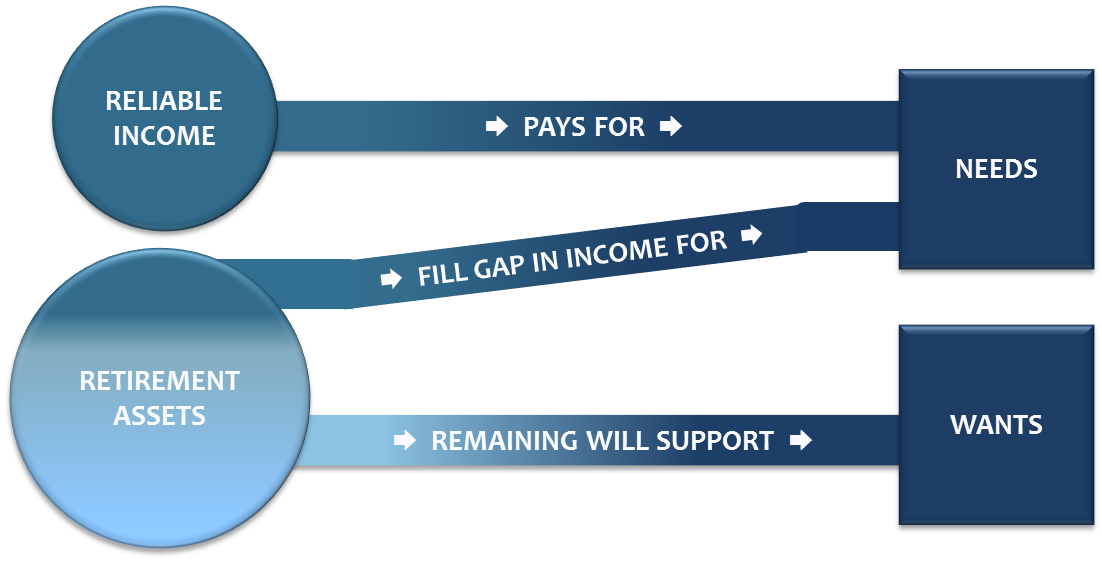Our Experience
Portfolio Management Driven by Your Individual Targets
Each of our clients has an individualized Investment Policy Statement (IPS) developed for them at the outset of our relationship and updated annually. The IPS establishes the various asset classes that will be used in the portfolio, the assumptions being used regarding risk and return of each asset class, the allocation constraints for maximums and minimums for each of those asset classes, and the objective return for the portfolio for the coming year.*
Within an advisory fee-based relationship, we track the performance and progress of the portfolio and make tactical changes during the year in order to help reach the goals we have mutually defined. Our clients are always able to answer the question "How are we doing?" based upon their stated goals and the quarterly performance reports they receive.
Retirement Income Replacement
There are many decisions and trade-offs facing you as you consider your next phase of life. Questions such as; " What are my goals for retirement? How much income will I need? What do I want to do with my money and my time? What benefits can I expect? What about my health?" All of these issues need thoughtful attention. We have the tools and resources to help you evaluate and make these decisions so that your confidence in a secure retirement is increased.
We combine four elements—reliable income, retirement assets, your needs, your wants—in order to provide a clearer understanding of your financial picture and the income sources that will be used to cover retirement expenses. “Needs,” during retirement, are defined as essential expenses you must meet and are based on your own values and priorities. Examples of needs include mortgage or rent payments, groceries, household utilities, etc. “ Wants” are expenses that are non-essential, but ideal in retirement. They reflect your vision of retirement. For example, traveling to visit family may be a necessity; while the additional expense of taking an annual trip to Europe might be a want.
After identifying retirement spending “needs” and “wants,” we identify the two types of income that will help fund each: reliable income and retirement asset income. Reliable income represents consistent income you receive monthly or annually that will be used to cover your expenses in retirement: Social Security, pension payments, and income from employment. We use specialized software to help our clients evaluate their Social Security benefits. Since many of those who are drawing Social Security retirement benefits are possibly receiving permanently reduced amounts due to timing decisions, we stress to clients the importance of allowing us to help them analyze this decision. The second source of income is generated by your retirement assets including 401(k) plans, IRAs, checking accounts, bank accounts, CDs, brokerage accounts and annuities. The growth and income from these assets is used to fill the “needs” gap, if one exists, with the remainder supporting your wants.

Using our Goal Planning & Monitoring (GPM) tool, our clients are able to visualize and manage their financial goals. Once we analyze your circumstances and determine an ideal withdrawal rate, we then keep you on track by using GPM as the baseline against which we test future results.
*The projections or other information generated by Goal Planning & Monitoring regarding the likelihood of various investment outcomes are hypothetical in nature, do not reflect actual investment results, and are not guarantees of future results. Goal Planning & Monitoring results may vary with each use and over time. In a fee- based account clients pay a quarterly fee, based on the level of assets in the account, for the services of a financial advisor as part of an advisory relationship. In deciding to pay a fee rather than commissions, clients should understand that the fee may be higher than a commission alternative during periods of lower trading. Advisory fees are in addition to the internal expenses charged by mutual funds and other investment company securities. To the extent that clients intend to hold these securities, the internal expenses should be included when evaluating the costs of a fee-based account. Clients should periodically re-evaluate whether the use of asset-based fee continues to be appropriate in servicing their needs. A list of additional considerations, as well as the fee schedule, is available in the firm's Form ADV Part 2A as well as the client agreement. Services rendered will be dependent on applicable agreements.

